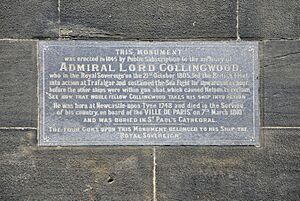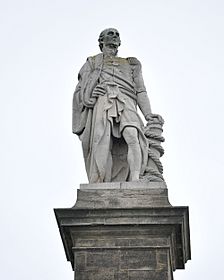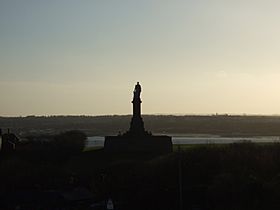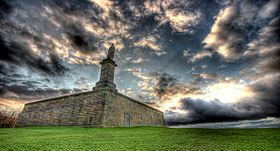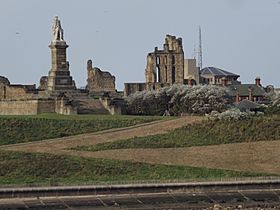Collingwood Monument facts for kids
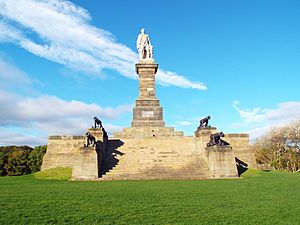
The memorial in June 2016
|
|
| Location | Tynemouth, Tyne and Wear |
|---|---|
| Designer | John Graham Lough and John Dobson |
| Type | Statue |
| Material | Marble and Sandstone |
| Height | 23 feet (7.0 m) |
| Completion date | 1845 |
| Dedicated to | Cuthbert Collingwood, 1st Baron Collingwood |
The Collingwood Monument is a special statue in Tynemouth, England. It's dedicated to Vice Admiral Lord Cuthbert Collingwood. He was a very important admiral during the Napoleonic era, known for being second-in-command to Admiral Lord Nelson at the famous Battle of Trafalgar. Some people call Collingwood the "forgotten hero" of Trafalgar. The monument was designed by John Dobson and the statue was made by John Graham Lough. You can find it near Front Street in Tynemouth, looking out over the River Tyne.
Contents
Who Was Lord Collingwood?
Lord Collingwood was born in Newcastle upon Tyne. His father was a merchant. He went to the Royal Grammar School. At just 12 years old, he joined the Royal Navy as a volunteer. He continued his training under his cousin, Captain Richard Brathwaite.
Collingwood served in the British Naval Brigade during the Battle of Bunker Hill. In 1775, he became a lieutenant. His first command was a ship called HMS Badger. He took over this command from Horatio Nelson. His first big command was HMS Sampson.
The Battle of Trafalgar
During the important Battle of Trafalgar, Lord Nelson was sadly killed. Collingwood then took charge of the British fleet. He moved to HMS Euryalus and led the fleet. He finished the battle plans that he and Nelson had made together.
For his brave actions, Collingwood received thanks from both parts of the Parliament. He was also given a yearly payment of £2,000. On November 9, 1805, he was promoted to Vice-Admiral of the Red. He also became a noble, known as Baron Collingwood.
Later Life and Legacy
In 1805, Collingwood became the leader of the Mediterranean Fleet. He asked to leave his command, but the government needed him. They said his country still needed his skills against France. However, his health became very poor in 1809. He was finally given permission to go home.
In 1810, Collingwood passed away from illness. He was on board HMS Ville de Paris while sailing back to England. He was buried next to Lord Nelson in St Paul's Cathedral. During his career, he fought in several wars. These included the American Revolutionary War, the French Revolutionary Wars, and the Napoleonic Wars. He earned three Naval Gold Medals. Only two other people have ever received three of these medals.
About the Monument
The Collingwood Monument was built to remember Lord Collingwood. It also celebrates his connection to North Shields. It was placed so everyone could see it from the River Tyne. People raised money to build it. John Dobson was the architect, and John Graham Lough created the statue.
Design and Features
The monument has a tall, wide base. It has small openings and a door at the back. A set of steps leads up to the base. Walls are on either side of these steps. On these walls are four cannons. These cannons came from HMS Royal Sovereign. This was Collingwood's main ship during the Battle of Trafalgar.
The statue of Collingwood stands on top of this base. He is wearing his Royal Navy uniform. A cloak is draped over him. His right hand rests on a bollard, which is a post used for tying ropes.
When It Was Built
The main part of the monument was finished in 1845. The four cannons were added a few years later, in 1849.
What the Inscription Says
The monument has words carved into its base. These words explain that the monument was built by the public. It honors Admiral Lord Collingwood. It mentions that he led the British fleet at Trafalgar in 1805. He fought bravely for a long time before other ships joined. Nelson himself said, "SEE HOW THAT FELLOW NOBLE FELLOW COLLINGWOOD TAKES HIS SHIP INTO ACTION."
The inscription also says Collingwood was born in Newcastle upon Tyne in 1748. He died serving his country on March 7, 1810, on the ship VILLE DE PARIS. He was buried in St Paul's Cathedral. Finally, it notes that the four cannons on the monument came from his ship, the "ROYAL SOVEREIGN."
Gallery


